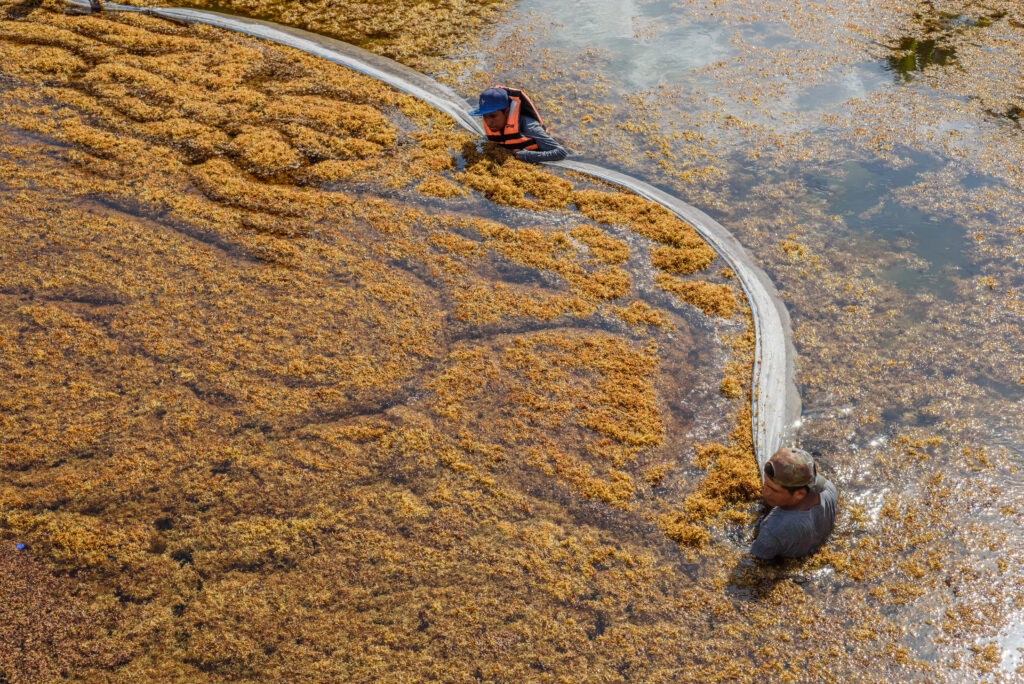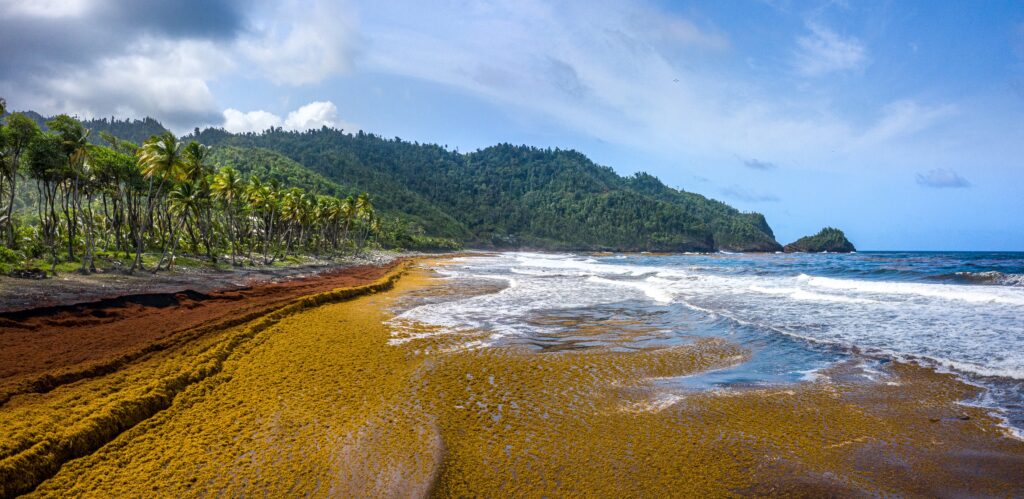A tide of sargassum seaweed is landing on beaches around the Gulf of Mexico, threatening livelihoods and creating a sulphurous stink. But does ‘the golden tide’ have a silver lining?
“The Stinky Seaweed Blob Approaching Florida Is Absolutely Humongous”
This April 4 headline from tech-news website Gizmodo is a ripper, invoking a 1950s alien attack on the sunny shores of the Orange State. Nonetheless, curious readers who click on the screamer will not be disappointed – indeed, they’ll encounter something even more ‘humungous’, ‘stinky’ and blob-like than they may be anticipating…
Earlier this year, the University of South Florida Optical Oceanography Lab put out an update that a floating seaweed biomass was threatening to break all records.
“[In March] the sargassum quantity in the Great Atlantic Sargassum Belt continued the overall increasing trend, again setting a record abundance for this time of year… There is already a sign that this year’s sargassum bloom will likely be the largest ever recorded, with major impacts [expected] throughout the next few months.”
This natural bloom of seaweed ebbs and flows (or more exactly grows and dies) each year, and is presently so big that it can be seen (and monitored) from space. Vast mats of sargassum stretch across the middle Atlantic Ocean from the Gulf of Mexico to the West Coast of Africa. Even though the word ‘blob’ is a misnomer, the discontinuous event still amounts to some 9,000 kilometres of floating seaweed.
Biologically speaking, sargassum is a genus of brown macroalgae. It has a golden hue and is rendered buoyant by grape-sized air sacs filled with oxygen. It floats freely and flourishes in warm waters to create an important living biome that harbours many species, including at least one fish that has evolved within it.
The seaweed is perfectly natural and certainly nothing new – indeed it raised the eyebrows of Christopher Columbus who found his three vessels surrounded by the stuff in 1492 while sailing for the ‘West Indies’. He used the Spanish word for brown seaweed (‘sargaço’) to name the seaweed-filled, landless sea he was crossing ‘Mar dos Sargaços’, or the Sargasso Sea. This same sea – actually a vast, shifting gyre measuring some six million square kilometres – hosts the biomass, and for centuries, sailors feared a slow, seaweed-bound death on the Sargasso. (In truth the seaweed grows thinly and presents no such danger, though it can slow small boats and foul engines.)
Sargassum became ‘a thing’ in 2011 because it began impacting modern livelihoods, washing up on the beaches of the southern United States and Central America.

Workers called ‘Sargazeros’ cleaning the beach full of sargassum algae in the Riviera Maya, Mexico
The loudest voices have been Floridians, whose beachfronts have been swamped from May to June with a ‘golden tide’. When these inundations begin to rot, they release hydrogen sulphide, creating a literal and political stink and threatening huge commercial interests including real estate and tourism.
According to the Optical Oceanography Lab the bloom has been growing exponentially – which is especially ominous given the June 2022 sargassum biomass peaked at a record-breaking 24 million tonnes. Meanwhile, the cost of remediating inundations is also growing…
In April this year, the Miami Herald reported the first sargassum arrivals, washing up on the beaches of Boca Raton and Fort Lauderdale, and warned that 2023 costs were certain to rise: “Miami-Dade County’s spending on seaweed cleanup has risen from $2.8 million during the 2020 sargassum season to $3.9 million during last year’s season. Now the county is asking the state Legislature for an extra $2 million to fund sargassum removal, which would bring this year’s total spending on seaweed cleanup to about $6 million.”
The picture is just as troubling in less wealthy countries to the south: Belize, Honduras, Jamaica, Cuba, Mexico, the Dominican Republic and Barbados are all visited by sargassum. As well as adversely affecting tourism, the influx is the bane of local fishermen.
In shallower waters, especially on reefs, the ecological impact can be catastrophic. Towards the southern reaches of the Gulf of Mexico, blankets of seaweed prevent light from penetrating, causing the death of corals and seagrasses. These in turn decompose to absorb oxygen, which further impacts fish, crustaceans, and turtles.
Sargassum has also begun to focus minds because it’s yet another environmental red flag.
The seaweed is flourishing for two reasons, neither of them good: the oceans are warming, and agricultural run-off is boosting ocean levels of nitrogen, phosphorus and other waste. Not unrelated, the bloom is shifting southwards, out of the Sargasso towards the mouth of the Amazon off Brazil, where increased farming and deforestation are serving to boost pollutants in the world’s largest river.
So is there any good news in what seems like another biological imbalance afflicting our planet?

Atlantic coast of Dominica covered with sargassum
Vincent Doumeizel co-leads the Global Seaweed Coalition and is an adviser to the UN Global Compact. While acknowledging the issue (and more exactly, humanity’s part in creating it) he argues that the algae could be a means to a brighter future, helping to alleviate issues like hunger, global warming, pollution and poverty.
“Seaweed is too often perceived as a risk,” he writes in a feature for Time magazine titled ‘How to Harness Mega Seaweed Blobs For a More Sustainable Future’. “On the contrary, it represents an opportunity. Its bad reputation is linked to the economic and ecological damage caused throughout the world by tides of seaweed that we’ve been unable to control or fully understand. So we must ask ourselves: What keys to progress might be hidden in seaweed and in our capacity to rediscover the ocean today?”
Doumeizel suggests that sargassum’s alginate holds the biggest promise and has already stimulated investors around the world to look at sargassum as a raw material for biodegradable packaging. Other investors are looking to the seaweed for animal feed, efuels, cosmetics and fertilisers.
Carbonwave is a Boston- and Puerto Rico-based start-up that recently secured US$5 million investment to scale production of its sargassum-based emulsifier for cosmetics. The emulsifier is an alternative to petroleum-based ingredients and is a bi-product of making sargassum fertiliser – itself a cleaner alternative to making nitrogen-based fertiliser.
In Jamaica, Awganic Inputs is turning sargassum into affordable animal feed for goats. The nation’s appetite for goat is such that it runs up an annual import bill of more than US$15 million; Awganic founder Daveian Morrison aims to make the country more self-sufficient by increasing local herd sizes to more than triple the national animal count. In addition, he’s turning rotting sargassum into an environmentally-friendly charcoal fuel; his sargassum ‘ecoal’ is said to burn cleaner and longer.
An unusual use has been found for sargassum harvested on the coast of Puerto Morelos in Mexico. In 2022, the Mexico News daily newspaper reported on Omar Vázquez Sánchez, who built 13 homes for low-income families using ‘sargablocks’ made from 40% seaweed and wet earth. Dubbed ‘Señor Sargazo’, Sánchez has 16 full-time employees collecting sargassum to feed his block-making machine. Each house constructed from sargablocks contains about 20 tonnes of seaweed and, according to studies by the National Autonomous University of Mexico, are more resilient than those made with traditional adobe blocks.
These initiatives, however, remain dwarfed by the monster influx. Expanded operations, new innovations and larger-scale solutions will be required – and these will not be without their challenges.
A 2021 White Paper from the UN Environmental Programme entitled ‘Turning the crisis into an opportunity’ advocates for regional and cross-border co-operation and coordination. The authors argue locating industrial processing plants will be problematic because the algal blooms are unreliable and their influx patterns hard to predict. They say standards will need to be set for harvesting and processing sargassum since it harbours heavy metals like arsenic. And they advocate for mounting a coherent response to ‘apply effort and resources, fill gaps, recover costs, and promote synergies between existing initiatives’.
Vincent Doumeizel is similarly realistic about what’s required to innovate and scale up production, but he remains upbeat that we will soon come to see seaweed not as an invasive force, a risk or a nuisance, but something precious. Species of ‘seaweed’, he argues, are ill-served by their name: “Let’s call them ‘sea vegetables’, so that people can understand how delicious they are,” he says in an interview with the UN Global Compact. “Let’s call them ‘sea forests’ so that people can find a way to protect them.
“It’s not something unwanted you have in the garden. It’s the greatest untapped resource we have on the planet.”



